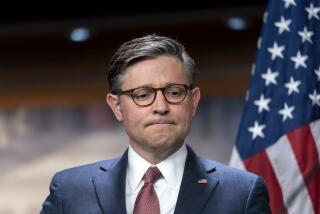Montana Leader Blames Clinton for Extent of Fires
- Share via
WASHINGTON — The governor of a state racked by the worst wildfires in half a century blamed the Clinton administration Sunday for failing to act on evidence that the Western states were increasingly prone to ravaging fires.
“Everybody was warned of this . . . and what I’m saying is we have not attached the right priority to these issues,” Montana Gov. Marc Racicot, a Republican, said on “Fox News Sunday,” as fire officials reported more than 1.6 million acres ablaze in 13 Western states.
Racicot said Congress was first warned of the hazardous forest conditions in 1993, warnings echoed by Cabinet members in 1997 and by the General Accounting Office, the investigative arm of Congress, in 1998.
But Clinton administration officials defended their response to the blazes, saying 98% of the fires have been put out. They said the fires were the result of what Agriculture Secretary Dan Glickman called “a perfect storm” of tinderbox conditions--high winds and forests thick with fuel after more than a century of fire suppression.
Nightmare weather conditions have combined to bring about a worst-case scenario for U.S. firefighters, much as converging hurricanes made for disaster in the recent book and movie “The Perfect Storm,” Glickman said.
“We have the hottest, driest weather in perhaps 50 years; we have thousands of lightning strikes an hour; we have 300 new fires every day in the West, largely because of lightning strikes,” he said.
“The convergence of that hot, dry weather coupled with a policy of Congress and administrations for more than 100 years of suppressing nearly every forest fire have combined to leave many fuels available for burning.”
Forests are ablaze in states including Montana, Idaho, Washington and South Dakota, where more than 184,000 acres have been consumed. Gusty winds and hot, dry weather were complicating firefighting efforts Sunday and are expected to continue across much of the region through early this week.
In Montana, one of the worst hit states, officials said two major fires burning near the Bitterroot National Forest had combined to form a monster 255,000-acre blaze and forced the evacuation of 700 homes in recent weeks.
With federal officials calling the fires the worst in 50 years and more than 25,000 people involved in the firefighting effort, officials are taking a new look at whether blazes of such magnitude could have been prevented. Glickman defended the years of putting out fires, saying firefighters and policymakers had been acting to save lives and property. But he said more attention was needed to launching prescribed burns to thin out forests that have been allowed to thrive for too many years.
Fires are a natural way for ecosystems to renew themselves and clear out underbrush. But as the West has become more populated, fires are rarely allowed to burn for fear of endangering people and property.
Racicot said federal, state and local governments have spent more than $100 million so far this year to fight the fires, and he warned of spiraling costs and economic losses if the fires are not soon brought under control.
“We have 3,000 structures that are threatened. We’ve lost in excess of 200 different structures, many homes, and the overpowering destruction to our landscape is something that we’ll never ever be able to fix in our lifetimes,” he said.
Racicot said the administration has neglected recommendations to eliminate nonnative species to thin out the forests and has failed to conduct enough prescribed burns to reduce underbrush throughout the West’s vast forests.
“I want healthy forests, and I’ve been asking for that and so have many others for a long period of time, and what I’m saying is that the administration on their watch has not prioritized this issue,” Racicot said.
More to Read
Sign up for Essential California
The most important California stories and recommendations in your inbox every morning.
You may occasionally receive promotional content from the Los Angeles Times.













